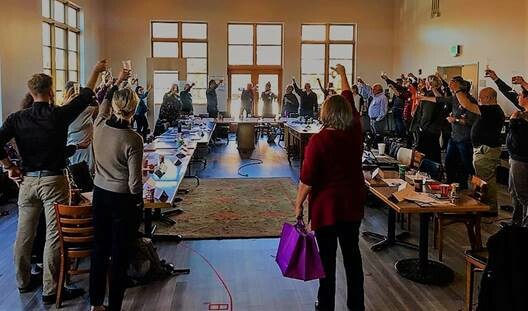Twice annual fee-free convenings with travel stipends provided time and space for the membership to meet face to face to bounce ideas and theories off each other. And it worked. For example, the combined problem of “one-and-done” productions and widespread “world premiere-itis” was tackled by the revolutionary Rolling World Premiere (RWP) program, which supports three or more entirely separate and distinct full productions of a new work within a twelve-month period, with the playwright’s participation in each. The Network also funded embedded residencies, which were designed to mentor rising and career-transitioning theatremakers in the day-to-day operations of a new play–focused organization. It began boosting the signal of new works–focused writers, directors, and producers as they moved into the field and expanded their new play bona fides with special programs, commissions, and travel support. And it took on the field’s perceived submission issues and the inability of producers to find the play that was “just right” by developing the New Play Exchange, a tool that has fundamentally changed the ways new plays are shared and discovered.
In just over twenty years, that small but mighty group of revolutionaries has grown to include the artistic, management, and literary leadership of more than 130 professional, not-for-profit theatres; over 300 playwrights, directors, dramaturgs, and producers who are the alumni of NNPN’s programs; and a dream team of industry experts, patrons, and funders who serve as its advisors and ambassadors. The Network is aided by two full-time staff members, three part-time hourly folks, and two wonderful long-term consultants, as well as the occasional project- focused outside professionals.
Whatever current issue was plaguing the field—the one everyone was talking about and no one was working on—they tackled by devising, developing, and piloting programs in response.
Plays and playwrights supported by NNPN programs have received hundreds of subsequent productions and citations in markets across the world; have won the Pulitzer Prize and the Steinberg Distinguished Playwright and Steinberg/ATCA, Stavis, PEN, and Blackburn awards; and have been adapted into feature films. Careers have been impacted by NNPN’s support, and playwrights who might have otherwise only enjoyed localized success have become national treasures. The New Play Exchange, which just celebrated its fifth birthday, includes information on more than 7500 playwrights and over 30,000 plays. Its robust, multifaceted search function lets its 10,000+ worldwide readers find the play they are seeking to read or produce. And with the recent addition of higher education subscriptions, nearly 400,000 students now have access to this astounding database.
So many challenges met and addressed since NNPN began—and yet, as the board of directors came together in advance of NNPN’s twentieth anniversary to craft the strategies that would carry the organization into the future, we came face to face with one of the most pertinent challenges facing our industry: we, as a governing body, were really, really white.
NNPN’s board of directors included a voting representative from each of its thirty-two core member theatres, two representatives from its constituencies, and six to eight industry leaders and philanthropists who supported the Network as donors and advisors. As we looked around at those who comprised the board—artists and advocates who were clearly and demonstrably focused on supporting new works penned by the best writers in the American theatre and that spoke to diverse communities in which our members made and shared work—we couldn’t deny our lack of diversity.
We asked our core member theatres for demographic information about their leadership, staff, boards, artists, and programming. The results were not surprising: NNPN theatres were producing new plays. Lots of them. Many of them were written by and included roles for women and people of color. They were hiring artists of color—lots of them, too. Staff diversity was increasing. Our theatres continued to work hard to be vital and impactful and to regularly and deeply connect with their audiences and communities. But we also found that our member theatres, like most in America, are primarily white institutions, run primarily by white leaders and boards.
NNPN’s twenty years of leaning into tough issues had uniquely positioned the organization at the nexus of the artists, institutions, and audiences who make up the new play field—poising us to help shape and fuel innovation in this area. And remember: NNPNers love a challenge.
So the discussions began. We couldn’t demand that our member theatres change their leadership, and we couldn’t make them refocus their governance activities through a lens of equity, diversity, and inclusion. But we could ask them to. We were determined to illuminate the leaders of NNPN’s member theatres, provide context and education, create space for examination and reflection, put words and actions to a new vision, and, as per our history, do something revolutionary to jumpstart that change.
With the help of Lisa Mount and Keryl McCord of Artistic Logistics—two brilliant arts champions, visionaries, and equity, diversity, and inclusion consultants—NNPN began what would become a five-step, twenty-four-month process examining the makeup of the organization and its history, programs, impact, and future.
In December of 2017, NNPN’s board, with the help of Lisa and Keryl, began interrogating and tracing the roots of the deeply embedded systemic racism within our country and our field. Armed with a burgeoning understanding of the complex ways theatremakers and arts leaders have supported this system, the board determined that our next strategic plan would examine all the Network’s policies and programs through a lens of equity, diversity, and inclusion. (NNPN recognizes that this term is fraught, but it was the one that we settled on to begin the work.) We needed to change NNPN into a replicable model of the diverse and inclusive ecosystem we wanted the American new play field to become. In order to motivate change outside of our organization, we would have to commit to embodying that change ourselves.
We came face to face with one of the most pertinent challenges facing our industry: we, as a governing body, were really, really white.
A strategic planning committee comprised of people from each of NNPN’s constituencies—its member theatres, programmatic alumni, and ambassadors—was formed and the work began. Led by Lisa, Keryl, and Seth Rozin—artistic director of Philadelphia’s InterAct Theatre and a founder of NNPN—the committee met every three weeks to determine a format for the plan. Subcommittees worked in smaller groups, sometimes with outside help, on topics determined in the full committee check-ins. The very essence of NNPN was put under a microscope, and, as a result, the mission, vision, and values of the organization were revised. In June of 2018, they were approved by the board.
The shift in the mission was slight. Rather than calling NNPN “the country’s alliance of nonprofit theatres that champions the development, production, and continued life of new plays,” it became “an alliance of professional theatres that collaborate in innovative ways to develop, produce, and extend the life of new plays.” The revised vision and values, though, clearly voiced the Network’s newfound commitment to move both itself and the field forward:
Vision
National New Play Network envisions a robust, equitable, and inclusive new play ecology that reflects a broad range of aesthetics.
Values
National New Play Network believes:
- commitment to diverse stories, artists, audiences, institutions, and leadership is essential to an equitable new play field;
- new plays are vital to our communities because they reflect, chronicle, and question the ideas, issues, and stories of our time; and
- collaboration is indispensable to the success of new plays.
At the same meeting where these new statements were approved, the strategic planning committee presented a major finding: the fastest and most surefire way for NNPN’s board to reflect that diverse and inclusive new play ecology was to disband, regroup, and start all over. The existing board spent a long day discussing the ramifications of the change; the potential pros and cons of the undertaking; what it would mean to NNPN’s membership, constituencies, programs, and the field; and, perhaps most importantly, how this choice could be used as a catalyst for change internally and externally. By the end of the afternoon, we agreed to change the very essence of NNPN’s structure: we would begin the process of decoupling governance and membership, and we would create a new board of directors and new bylaws.
The strategic planning committee went back to work. By December of 2018, we had designed a plan for a new board of directors that would include fifteen to twenty-five elected individuals, rather than theatre representatives. We determined to leave the officers in their roles for the initial term, in order to ensure continuity, and it was agreed that during the five years covered by the new strategic plan (FY20–25), the core member theatres would retain a level of control by having a majority of the board seats go to individuals affiliated with them. On top of that, core members theatres would continue to receive travel stipends to send representatives twice annually to determine which theatres were granted core membership status and to approve of any major changes or additions to the NNPN programmatic menu.
We needed to change NNPN into a replicable model of the diverse and inclusive ecosystem we wanted the American new play field to become.
Next, we created a transition plan that would change the demographics of our board in a very intentional way. The new board, which would be seated on 1 August 2020, was to be at least 50 percent female-identified, at least 30 percent of its members would identify as people of color (by 2025 that number must rise to at least 50 percent), and that there was to be a mix of NNPNers both old and new. Artistic, management, and literary leaders would be joined by alumni and ambassadors. All regions of the country were to be represented, as well as companies with small, medium, and large budgets.
NNPN’s nominating committee, comprised of members from the “old board”—including many, like me, who had more than fifteen years of service—put out a call for applications for the new board among our varied constituencies. We received interest from a wonderfully diverse group of candidates, all of whom have a common love of new work, the Network, and the new play field. The applications, including resumes as well as responses to several key questions, were evaluated; a nine-point demographic matrix was created to ensure compliance with the mandates around the composition of this new board we had established. The applicants were charted according to pronouns, racial identity, NNPN constituency, years of experience with the Network, geolocation, career focus, and the size of the theatres with which they were affiliated or worked most often. Once we ensured all the data points were covered, a slate was crafted and presented for approval in June of 2019. The slate was approved unanimously.
On 31 July 2019, National New Play Network dissolved its existing board and seated a new group of directors, jumpstarting the process of bringing equity and inclusion to NNPN’s governing body and, in the long run, to its many theatres.




Comments
The article is just the start of the conversation—we want to know what you think about this subject, too! HowlRound is a space for knowledge-sharing, and we welcome spirited, thoughtful, and on-topic dialogue. Find our full comments policy here
This is a journey way worth documenting. Thanks so much for sharing and for making clear the intentions and actions at each step of the way. We are all in this together, making our path by walking.